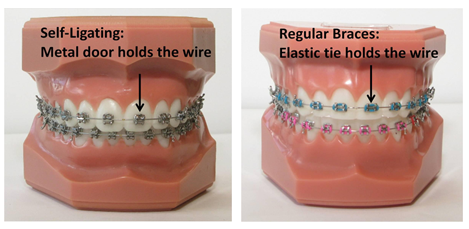 Self-ligating braces are braces that use little metal doors to hold the wires instead of elastic ties. There are many companies that advertise different names for these braces. The most popular self-ligating braces are Damon™, Speed System and In-Ovation. These types of braces have been around for more than 20 years, but they have recently gained popularity as these companies have begun marketing directly to the patients and consumers.
Self-ligating braces are braces that use little metal doors to hold the wires instead of elastic ties. There are many companies that advertise different names for these braces. The most popular self-ligating braces are Damon™, Speed System and In-Ovation. These types of braces have been around for more than 20 years, but they have recently gained popularity as these companies have begun marketing directly to the patients and consumers.
Are they better? The simple answer is no. The more complicated answer is in some ways yes and in other ways no. The most important thing to understand is that braces do not move teeth! Wires move teeth! Braces are simply handles that are glued-on teeth to hold the wires in place so the wires can move the teeth. Teeth move when wires apply gentle, consistent pressure (force) over time. The teeth have no idea whether the wire is being held in place by a metal door or an elastic tie.
What primarily controls the speed of tooth movement is the biology of our bodies. Within our bones, certain cells (osteoclasts) eat away bone, and other cells (osteoblasts) deposit bone as teeth move. This process can only happen so fast and depends more on an individual’s age and genetics than what type of braces they have. For example, a young kid whose bone is constantly changing will have very rapid movement, whereas an older adult whose bone is fairly stable will have slower movement.
Advantages to self-ligating braces:
- Self-ligating braces can speed up the first stage of orthodontics (alignment) because initially there is a little less friction between the wires and the metal doors when teeth are rotating and straightening out.
- The metal doors are a little smaller than the elastic ties so they can be a bit easier to clean in some cases. Most patients, however, will still need elastic chains at some point (to close spaces) during treatment, so this advantage only applies to few patients.
Disadvantages to self-ligating braces:
- The difference between a good orthodontist and a great orthodontist is in the details. Any orthodontist can generally line up your teeth and make them look okay. In fact, for most people it only takes about three to six months to straighten the teeth. But placing the teeth in the precise position for ideal aesthetics and that “Hollywood smile” requires maximum control.
Self-ligating braces generally have more “slack” in them (the wire fits a little more loosely in the bracket). This means that it is more difficult for the orthodontist to make bends and control the fine details during the last stage of orthodontics. Thus, the last stage of orthodontics with self-ligating braces usually takes a little longer than with traditional braces, and it is more difficult to get a precise result. For this reason, self-ligating braces are not any faster when you consider overall treatment time.
- Door fatigue. Over time, self-ligating doors can fatigue, which means they do not stay closed and we have to use regular ties anyway.
- Self-ligating braces are more expensive, and that cost is passed to the patient. If they were superior, it would be worth the cost. Since they are not superior, it is not worth making the patient pay more.
Research
Depending on who you talk to or what you read, you will get different answers. If you talk to someone who likes self-ligating braces, they will tell you they are better. If you talk to someone who does not like them, they will tell you they are not any better.
The truth is in the research. A significant amount of research has been done over the past several years to compare self-ligating braces to traditional braces. Many of the studies have been done by companies with a financial interest (which means the company that is selling the braces is paying for the study). Those studies are unfortunately not reliable.
Other institutions who do not have a financial interest in the product (such as colleges and universities) have done many studies as well. These are called independent studies. Independent research confirms there is no difference between self-ligating and traditional braces when it comes to speed of treatment. No matter what the advertisements say, unbiased independent research shows they work at the same speed.
Any orthodontist can order any type of braces he or she prefers. Any company will sell any type of braces to any orthodontist. Most orthodontists order the braces they like best.
Dr. Robert Taylor is extremely particular with his patients and wants them to have the best possible result!!! During his first few years of practicing orthodontics, Dr. Taylor used traditional braces, Damon braces and In-Ovation braces. While there was not much difference in the outcomes, Dr. Taylor noticed the results with traditional braces were a little more detailed, refined and crisp. With the control the traditional braces gave him, he was able to position teeth just a little better. For this reason, he generally recommends using American Master Series traditional braces.
If a patient prefers, Dr. Taylor offers self-ligating brackets in Orem, Utah. To learn more, contact Taylor Family Orthodontics today at 801-226-6611 and schedule a consultation with our orthodontist.

